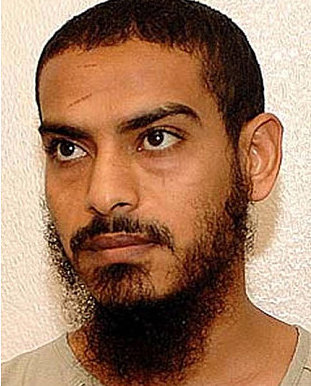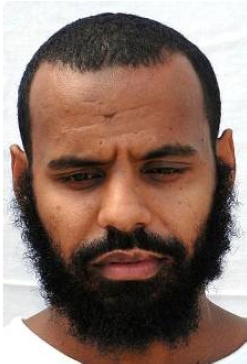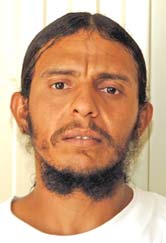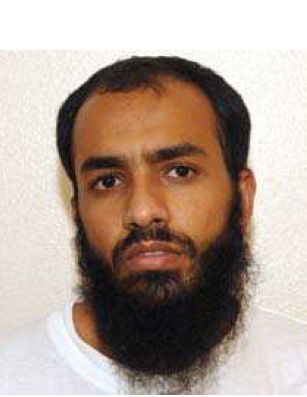
Abdul Zahir is a citizen of Afghanistan, who was held in extrajudicial detention in the United States' Guantanamo Bay detention camps, in Cuba. He was the tenth captive, and the first Afghan, to face charges before the first Presidentially authorized Guantanamo military commissions. After the US Supreme Court ruled that the President lacked the constitutional authority to set up military commissions, the United States Congress passed the Military Commissions Act of 2006. He was not charged under that system.

Bashir Nashir Ali Al-Marwalah is a Yemeni, who was captured in Pakistan, on September 11, 2002, and transferred to extrajudicial detention in the United States Guantanamo Bay detention camps, in Cuba. His Guantanamo Internment Serial Number is 837. Joint Task Force Guantanamo counter-terrorism analysts reports that Al-Marwalah was born on December 1, 1979, in Al-Haymah, Yemen.

Musab Omar Ali Al Mudwani is a citizen of Yemen who was held in extrajudicial detention in the United States Guantanamo Bay detainment camps, in Cuba.

Ahmed Abdul Qader is a citizen of Yemen, who was held in extrajudicial detention in the United States Guantanamo Bay detainment camps, in Cuba from June 18, 2002, to January 14, 2015. His detainee ID number was 690. The Department of Defense estimated that Qader was born in 1984, in Sana'a, Yemen.

Muhammad Ali Abdallah Muhammad Bwazir is a citizen of Yemen, once held in extrajudicial detention in the United States Guantanamo Bay detainment camps, in Cuba. Bwazir's Guantanamo Internment Serial Number was 440. American intelligence analysts estimate he was born in 1980, in Hawra', Yemen.

Muhammad Ahmad Abdallah al-Ansi is a citizen of Yemen, held in extrajudicial detention in the United States Guantanamo Bay detention camps, in Cuba. His Guantanamo Internee Security Number is 029. American intelligence analysts estimate he was born in 1975, in Sanaa, Yemen. He was cleared for release on December 9, 2016, a recommendation made public on December 22. He was transferred to Oman with nine other men on January 16, 2017.

Mohammed Ahmad Said Al Edah is a citizen of Yemen who was held in the United States' Guantanamo Bay detainment camps, in Cuba, for fourteen and a half years. His Internment Serial Number is 33. Joint Task Force Guantanamo counter-terrorism analysts estimate he was born in 1962, in Hay al-Turbawi Ta'iz, Yemen.

Mohammed Ahmed Said Haidel is a citizen of Yemen, who was held in extrajudicial detention in the United States Guantanamo Bay detention camps, in Cuba. His Guantanamo Internment Serial Number is 498. Joint Task Force Guantanamo counter-terrorism analysts estimate that he was born in 1978, in Ta'iz, Yemen.

Ha'il Aziz Ahmad Al Maythal is a citizen of Yemen, who was held in extrajudicial detention in the United States Guantanamo Bay detention camp, in Cuba. American intelligence analysts estimate that he was born in 1977, in Zemar, Yemen.

Mustafa Abd al-Qawi Abd al-Aziz al-Shamiri is a citizen of Yemen who was held in extrajudicial detention in the United States Guantanamo Bay detainment camp in Cuba. Al Shamiri's Guantanamo detainee ID number is 434. The Department of Defense reports that Al Shamiri was born on July 7, 1978, in Sanaa, Yemen. He was released and sent to Oman with nine other men, on January 16, 2017.

Mashur Abdallah Muqbil Ahmed Al Sabri is a citizen of Yemen who was held in extrajudicial detention in the United States Guantanamo Bay detainment camps, in Cuba until April 16, 2016. Al Sabri's Guantanamo detainee ID number is 324.

Moath Hamza Ahmed al-Alwi is a citizen of Yemen, held in extrajudicial detention in the United States Guantanamo Bay detainment camps, in Cuba. His detainee ID number is 28. Guantanamo analysts estimated he was born in 1977, in Al Hudaydah, Yemen.

Idris Ahmed ʽAbd al Qader Idris is a citizen of Yemen, who was held in the United States Guantanamo Bay detainment camps, in Cuba. His detainee ID number was 035. American intelligence analysts estimate he was born in 1979, in Rada, Yemen. Idris was transferred to Oman on June 13, 2015, where the Government of Oman agreed to what the Department of Defense called "appropriate security measures". He arrived on June 8, 2002, he was held in extrajudicial detention, and never faced criminal charges. The Department of Defense never fully released its justification for holding Idris, but on April 25, 2011, the Guantanamo Bay files leak was published.

Salem Ahmed Hadi Bin Kanad is a citizen of Yemen, who was held in extrajudicial detention in the United States Guantanamo Bay detainment camps, in Cuba. His detainee ID number is 131. Joint Task Force Guantanamo counter-terrorism analysts reports that Hadi was born on January 15, 1976, in Hadhramaut, Yemen.

Ayoub Murshid Ali Saleh is a citizen of Yemen who was held in extrajudicial detention in the United States Guantanamo Bay detainment camps, in Cuba. His Guantanamo Internment Serial Number is 836. The Department of Defense reports that he was born on April 29, 1978, in Usabee, Yemen.

Shawki Awad Balzuhair is a citizen of Yemen, held in extrajudicial detention in the United States Guantanamo Bay detainment camps, in Cuba.

Omar Said Salim Al Dayi, also known as Omar Said Salem Adayn and Omer Saeed Salem Al Daini, is held in extrajudicial detention in the United States Guantanamo Bay detention camps, in Cuba. His Guantanamo Internee Security Number is 549.

Tolfiq Nassar Ahmed Al Bihani is a citizen of Saudi Arabia held in the United States's Guantanamo Bay detention camps, in Cuba. His Guantanamo Internment Serial Number is 893.

Muktar Yahya Najee Al Warafi is a citizen of Yemen, who was held in extrajudicial detention in the United States Guantanamo Bay detainment camps in Cuba. The Department of Defense estimate that Al Warafi was born in 1974, in Ta'iz, Yemen.

Muhammaed Yasir Ahmed Taher was a citizen of Yemen, who was held in extrajudicial detention in the United States's Guantanamo Bay detention camps, in Cuba. His Guantanamo Internment Serial Number was 679. American intelligence analysts estimate he was born in 1980, in Ibb, Yemen.




















